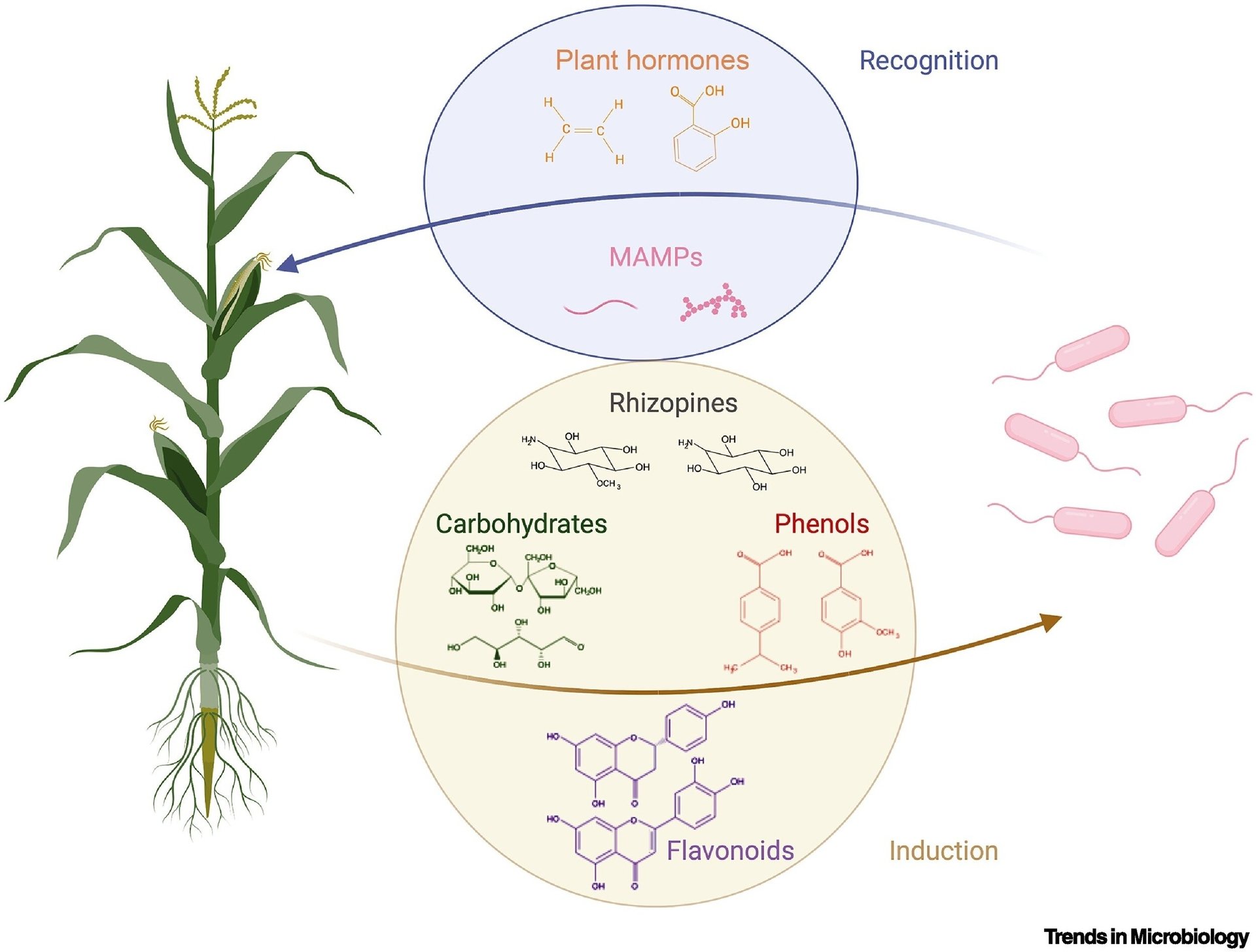May 21, 2025 | 07:34 GMT +7
May 21, 2025 | 07:34 GMT +7
Hotline: 0913.378.918
May 21, 2025 | 07:34 GMT +7
Hotline: 0913.378.918

Common chemical signaling mechanisms used for synthetic associations between bacteria with engineered crops. Credit: Trends in Microbiology
In a review article publishing in the journal Trends in Microbiology on September 26, a team of bacteriologists and plant scientists discuss the possibility of using genetic engineering to facilitate mutualistic relationships between plants and nitrogen-fixing microbes called "diazotrophs." These engineered associations would help crops acquire nitrogen from the air by mimicking the mutualisms between legumes and nitrogen-fixing bacteria.
"Engineering associative diazotrophs to provide nitrogen to crops is a promising and relatively quickly realizable solution to the high cost and sustainability issues associated with synthetic nitrogen fertilizers," writes the research team, led by senior author Jean-Michel Ané of the University of Wisconsin–Madison.
Diazotrophs are species of soil bacteria and archaea that naturally "fix" atmospheric nitrogen into ammonium, a source that plants can use. Some of these microbes have formed mutualistic relationships with plants whereby the plants provide them with a source of carbon and a safe, low-oxygen home, and in return, they supply the plants with nitrogen. For example, legumes house nitrogen-fixing microbes in small nodules on their roots.
However, these mutualisms only occur in a small number of plants and a scant number of crop species. If more plants were able to form associations with nitrogen fixers, it would lessen the need for synthetic nitrogen fertilizers, but these sorts of relationships take eons to evolve naturally.
How to enhance nitrogen fixation in non-legume crops is an ongoing challenge in agriculture. Several different methods have been proposed, including genetically modifying plants so that they themselves produce nitrogenase, the enzyme that nitrogen fixers use to convert atmospheric nitrogen into ammonium, or engineering non-legume plants to produce root nodules.
An alternative method—the topic of this review—would involve engineering both plants and nitrogen-fixing microbes to facilitate mutualistic associations. Essentially, plants would be engineered to be better hosts, and microbes would be engineered to release fixed nitrogen more readily when they encounter molecules that are secreted by the engineered plant hosts.
"Since free-living or associative diazotrophs do not altruistically share their fixed nitrogen with plants, they need to be manipulated to release the fixed nitrogen so the plants can access it," the authors write.
The approach would rely on bi-directional signaling between plants and microbes, something that already occurs naturally. Microbes have chemoreceptors that allow them to sense metabolites that plants secrete into the soil, while plants are able to sense microbe-associated molecular patterns and microbe-secreted plant hormones. These signaling pathways could be tweaked via genetic engineering to make communication more specific between pairs of engineered plants and microbes.
The authors also discuss ways to make these engineered relationships more efficient. Since nitrogen fixation is an energy-intensive process, it would be useful for microbes to be able to regulate nitrogen fixation and only produce ammonium when necessary.
"Relying on signaling from plant-dependent small molecules would ensure that nitrogen is only fixed when the engineered strain is proximal to the desired crop species," the authors write. "In these systems, cells perform energy-intensive fixation only when most beneficial to the crop."
Many nitrogen-fixing microbes could provide additional benefits to plants beyond nitrogen fixation, including promoting growth and stress tolerance. The authors say that future research should focus on "stacking" these multiple benefits. However, since these processes are energy-intensive, the researchers suggest developing microbial communities made up of several species that each provide different benefits to "spread the production load among several strains."
The authors acknowledge that genetic modification is a complex issue, and the large-scale use of genetically modified organisms in agriculture would require public acceptance. "There needs to be transparent communication between scientists, breeders, growers, and consumers about the risks and benefits of these emerging technologies," the authors write.
There's also the issue of biocontainment. Because microbes readily exchange genetic material within and between species, measures will be needed to prevent the spread of transgenic material into native microbes in surrounding ecosystems. Several such biocontainment methods have been developed in the laboratory, for example, engineering the microbes so that they are reliant on molecules that are not naturally available, meaning that they will be restricted to the fields in which the engineered host plants are present, or wiring the microbes with "kill switches."
The authors suggest that these control measures might be more effective if they are layered, since each measure has its limitations, and they stress the need to test these engineered plant-microbe mutualisms under the variable field conditions in which crops are grown.
"The practical use of plant-microbe interactions and their laboratory-to-land transition are still challenging due to the high variability of biotic and abiotic environmental factors and their impact on plants, microbes, and their interactions," the authors write.
"Trials in highly-controlled environments such as greenhouses often translate poorly to field conditions, and we propose that engineered strains should be tested more readily under highly replicated field trials."
(Phys)

(VAN) Attempts to bring down the price of the Japanese staple have had little effect amid a cost-of-living crisis.

(VAN) Fourth most important food crop in peril as Latin America and Caribbean suffer from slow-onset climate disaster.

(VAN) Shifting market dynamics and the noise around new legislation has propelled Trouw Nutrition’s research around early life nutrition in poultry. Today, it continues to be a key area of research.

(VAN) India is concerned about its food security and the livelihoods of its farmers if more US food imports are allowed.

(VAN) FAO's Director-General emphasises the need to work together to transform agrifood systems.

(VAN) Europe is facing its worst outbreak of foot-and-mouth since the start of the century.

(VAN) The central authorities, in early April, released a 10-year plan for rural vitalization.